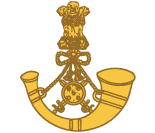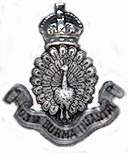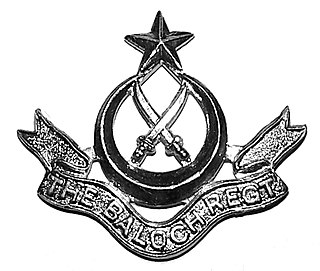
The Maratha Light Infantry is a light infantry regiment of the Indian Army. It traces its lineage to the Bombay Sepoys, raised in 1768, making it the most senior light infantry regiment in the Indian Army. The class composition of the regiment was and is primarily formed by hardy, frugal and disciplined Maratha recruits from the former Maratha Empire. The men are mostly drawn from all over the state of Maharashtra, with some percentage from Marathi-speaking areas of Karnataka including Coorg. The regimental centre has been in Belgaum, Karnataka, since 1922, which was part of the Bombay Presidency at that time. The battle cry of Maratha Light Infantry is, "Bol Shri Chhatrapati Shivaji Maharaj Ki Jai ".

The 129th Duke of Connaught's Own Baluchis was an infantry regiment of the British Indian Army raised in 1846 as the 2nd Bellochee Battalion. It was designated as the 129th Duke of Connaught's Own Baluchis in 1903, and became 4th Battalion 10th Baluch Regiment in 1922. In 1947, it was allocated to Pakistan Army, where it continues to exist as 11th Battalion of The Baloch Regiment.

The 8th Punjab Regiment was a regiment of the British Indian Army from 1922 to 1947. It was transferred to Pakistan Army on Partition of India in 1947 and merged with the Baluch Regiment in 1956.

The 15th Lancers (Baloch) is an armoured regiment of the Pakistan Army. It was formed in 1922 by the amalgamation of the 17th Cavalry and the 37th Lancers.

The 89th Punjabis was an infantry regiment of the British Indian Army raised in 1798 as a battalion of Madras Native Infantry. It was designated as the 89th Punjabis in 1903 and became 1st Battalion 8th Punjab Regiment in 1922. In 1947, it was allocated to Pakistan Army, where it continues to exist as 1st Battalion, The Baloch Regiment.

The 90th Punjabis were an infantry regiment of the British Indian Army. The regiment was raised in 1799 as a battalion of Madras Native Infantry. It was designated as the 90th Punjabis in 1903 and became 2nd Battalion 8th Punjab Regiment in 1922. In 1947, it was allocated to Pakistan Army, where it continues to exist as 2nd Battalion of The Baloch Regiment.

The 91st Punjabis was an infantry regiment of the British Indian Army. The regiment was raised in 1800 as a battalion of Madras Native Infantry. It was designated as the 91st Punjabis in 1903 and became 3rd Battalion 8th Punjab Regiment in 1922. In 1947, it was allocated to Pakistan Army, where it continues to exist as 3rd Battalion of The Baloch Regiment.

The 92nd Punjabis were an infantry regiment of the British Indian Army. The regiment was raised in 1800 as a battalion of Madras Native Infantry. It was designated as the 92nd Punjabis in 1903 and became 4th Battalion 8th Punjab Regiment in 1922. In 1947, it was allocated to Pakistan Army, where it continues to exist as 4th Battalion of The Baloch Regiment.

The 93rd Burma Infantry was an infantry regiment of the British Indian Army. The regiment was raised in 1800 as a battalion of Madras Native Infantry. It was designated as the 93rd Burma Infantry in 1903 and became the 5th (Burma) Battalion 8th Punjab Regiment in 1922. In 1947, it was allocated to the Pakistan Army, where it continues to exist as 5th Battalion of The Baloch Regiment.

The 130th King George's Own Baluchis was an infantry regiment of the British Indian Army raised in 1858 as the 1st Regiment of Jacob's Rifles or 1st Belooch Rifles. It was designated as the 130th Jacob's Baluchis in 1903 and became 5th Battalion 10th Baluch Regiment in 1922. In 1947, it was allotted to the Pakistan Army, where it continues to exist as 12th Battalion of The Baloch Regiment.
The 126th Baluchistan Infantry was an infantry regiment of the British Indian Army raised in 1825 as the 2nd Extra Battalion of Bombay Native Infantry. It was designated as the 126th Baluchistan Infantry in 1903 and became 2nd Battalion 10th Baluch Regiment in 1922. In 1947, it was allocated to the Pakistan Army, where it continues to exist as 7th Battalion of The Baloch Regiment.

The 124th Duchess of Connaught's Own Baluchistan Infantry was an infantry regiment of the British Indian Army raised in 1820 as the 2nd (Marine) Battalion 12th Regiment of Bombay Native Infantry. It was designated as the 124th Duchess of Connaught's Own Baluchistan Infantry in 1903 and became 1st Battalion 10th Baluch Regiment in 1922. In 1947, it was allocated to Pakistan Army, where it continues to exist as 6th Battalion of The Baloch Regiment.
The 26th Jacob's Mountain Battery was an artillery unit of the British Indian Army. The battery traces its origins to Golandauze Battalion (1826). In 1843 it became the 10th Company Golandauze Battalion of Bombay Foot Artillery, and became the 26th Jacob's Mountain Battery in 1903. In 1947, it was transferred to the Pakistan Army, where it exists as the 1st Jacob's Battery (Baloch) of The First (SP) Medium Regiment Artillery.

19th Battalion The Baloch Regiment is one of the oldest Light Anti-Tank Regiment of Pakistan Army. Initially raised as the Machine Gun Battalion of 10th Baluch Regiment in 1942, it was first designated as 53rd Regiment, Indian Armoured Corps and then re-designated as 17/10th Baluch. This unit has the unique honour of being the parent unit of Pakistan Army's special forces known as Special Service Group. Prominent officers including General Mirza Aslam Beg, General Pervez Musharraf have served in the unit and Maj Gen Abrar Hussain and Maj Gen Aboobaker Osman Mitha also known as AO Mitha have commanded this unit. Another famous officer was the brilliant Col. S.G. Mehdi, M.C, considered the 'Father of SSG" whose career was cut short when he refused to agree to a foolhardy scheme concocted by the Pakistan Army general Staff to launch para commandos in Indian Held Kashmir in 1965. The Operation called "Gibraltar" was the brainchild of Gen Akhter Malik, whose inordinate ambitions lead to this grand fiasco. Mehdi was sacked and the new commander was ordered to go ahead with the mission which was a total disaster.

General Sir Alfred Astley Pearson, KCB (1850–1923) was a British Indian Army officer.

The Bahawalpur Regiment was an infantry regiment with One artillery regiment known as 14 Abbasia Field Regiment Artillery of Pakistan Army. The regiment was formed in 1952 from the infantry battalions of the erstwhile Princely State of Bahawalpur, which had acceded to Pakistan in 1947. In 1956, the Bahawalpur Regiment was merged with the Baluch Regiment.
British East Africa 1896 is a Battle Honour awarded to the 24th (Baluchistan) Regiment of Bombay Infantry; an infantry battalion of the British Indian Army, which participated in the 1896 expedition to British East Africa to suppress a local rebellion.




















